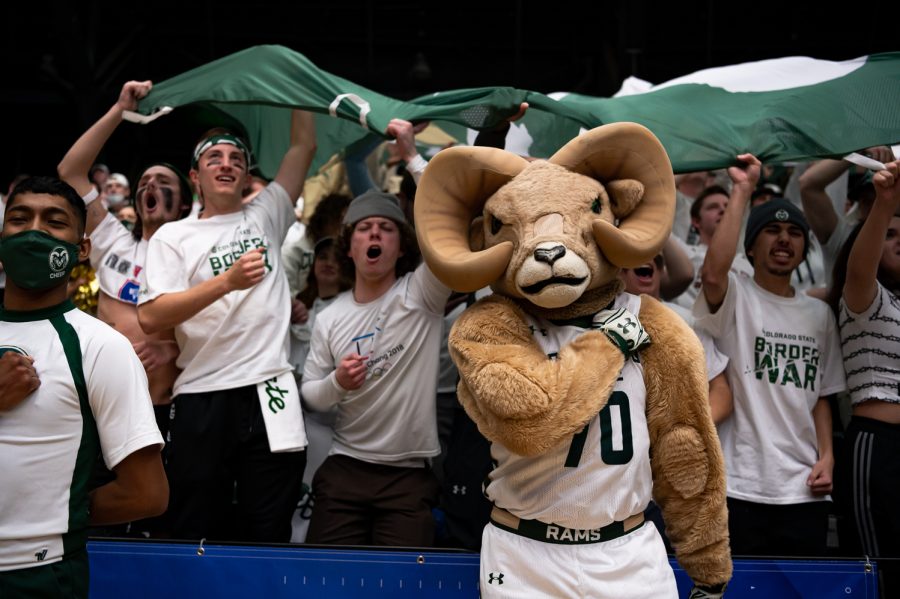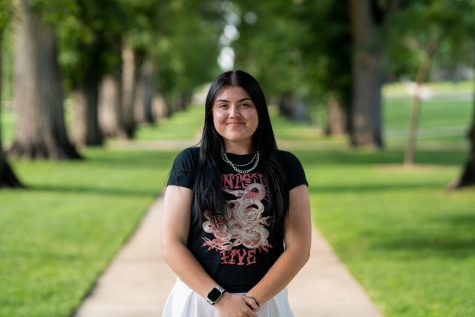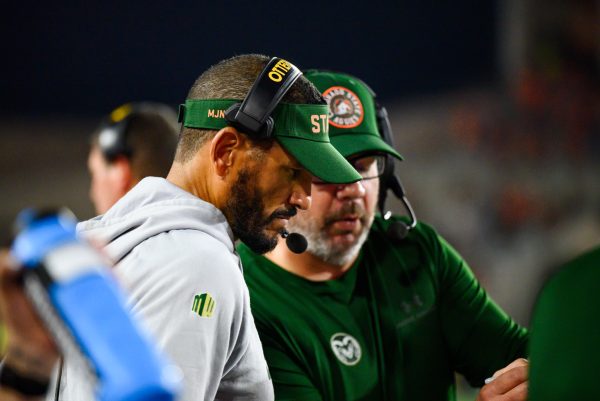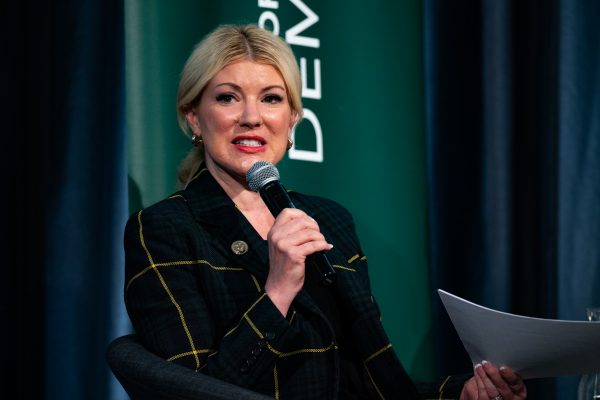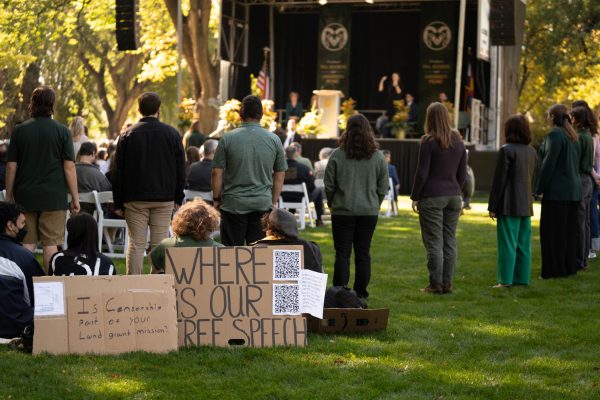Without national title, CSU Athletics still makes millions
Collegian | Milo Gladstein
Colorado State University fans hold up their hands and cheer with Cam The Ram during the CSU basketball game vs the University of Wyoming at Moby Arena Feb. 23. CSU won 61-55.
May 4, 2023
In the 2021-22 athletic season, over 85,000 student tickets were distributed at Colorado State University for football and men’s basketball games, expanding the college experience we’ve all become comfortable with again after an odd few years.
The experience of going to college-level football or basketball games can be some of the most memorable moments for students. However, creating just as noteworthy of an experience for the athletes is something athletic departments strive to achieve.
Success for an athletic department can be measured in a few different ways, but the general goal for every sport is to become conference and national champions. Getting to a national championship level isn’t an easy task, as the collegiate industry is one of the most competitive. Key things through the season can help a team, though, like doing well in a postseason conference play and making it to the Division I NCAA championship tournament.
CSU has felt the tough end of the competition, as they have never won a team national championship in any sport. Before getting to compete at the national level and benefit from it, the Rams have to perform well in the Mountain West Conference.
In the last 10 years, CSU Athletics earned 23 MW Tournament Championships: eight coming from women’s and men’s indoor track and field, six from women’s and men’s outdoor track and field, six from volleyball and three single championships for softball, women’s basketball and men’s cross country.
For CSU’s national level history, 12 Rams individually have won a Division I NCAA Championship in sports like wrestling, men’s and women’s indoor and outdoor track and field and women’s swimming.
Athletes, recruiters and fans benefit greatly from wins in the postseason in more ways than just the bragging rights. It’s obvious to say making money is a big positive to any department, and to do that, you need wins long before the postseason. Individual athletes’ and teams’ success can bring positive attention to athletic departments in hopes to be more competitive during recruitment times.
In the 2023 March Madness Tournament, San Diego State University, an athletic department in the Mountain West, made it to the championship game, where the Aztecs faced off against basketball icons at the University of Connecticut. While the Aztecs lost 76-59, their run benefitted the MW by covering 62% of the total $1.49 million that will be spread to the conference’s teams over the next six years.
In the 2021-22 season, Saint Peter’s University’s men’s basketball team’s quarterfinals game was the furthest a No. 15 seed team made it through the March Madness Tournament, upsetting teams like the University of Kentucky, Murray State University and Purdue University. The Peacocks saw $130 million in media value and a 47% increase in donors due to its Elite Eight run.
“Having a positive and engaging environment may be a stronger factor for recruits than a shiny new stadium, but proving the Athletics Department deserves that 1.4% support from the university is easier when you have the stalwart Rams representing green and gold.”
The CSU men’s basketball team got a chance that same year with a historic No. 6 seed ranking to only be taken down by the Big Ten University of Michigan Wolverines in the first round. Chances like this don’t come often for CSU’s recognizable teams like basketball and football, but they’re also not part of a billion-dollar conference like the Big Ten. Although resources are more limited for CSU Athletics, taking advantage of these postseason moments is crucial.
For some perspective, the University of Michigan Athletic Department made over $210 million in operational revenue in the 2021-22 year, and CSU made less than half of that at just over $61 million — the third highest in the MW. About 30% of that revenue comes from Canvas Stadium alone. However, the stadium’s money stays with the football program and doesn’t get spread to the rest of the department.
But before CSU can work toward the postseason, they get a little support from the university long before any of the seasons start. A common way athletic budgets are comprised is with a mixture of student fees, self-generated revenue and university support.
For the 2022-23 year, CSU’s total education and general expenses were $510,330,191. After taking out financial aid that returns to the university, $7,363,650 goes as direct support to the Athletic Department. While that is a lot of money to the average person, that’s only 1.4% of the entire University’s E&G budget but contributes to about one-third of the revenue budget for the Athletic Department.
For the 2023 fiscal year, CSU’s Athletic Department nonstadium budget was $41.9 million, so you may be wondering who is in charge of managing and disbursing this budget every year. Matt Klein, a CSU alumnus and Colorado local, has been working with CSU’s athletic budget department for the last decade but more recently became the senior associate athletic director for business operations and the chief financial officer.
Klein works closely with Joe Parker, CSU’s director of athletics, and Steve Cottingham, the deputy director of athletics, to organize the needs and priorities of the coming year. With a budget in the bottom half of the NCAA, Klein has to take the approach of being resourceful for the greater good of all 14 teams, as the capabilities of CSU’s budget only go so far.
“I think we always look at the greater good — it’s a ripple effect,” Klein said. “We always talk about ourselves as the department of athletics. Every team (has) tunnel vision of, ‘What I need is the most important,’ and that’s the great balance. Where do we put our resources to benefit the department the best?”
Over half the expenses in 2022 for CSU Athletics, including Canvas Stadium, was spent on the general operations and compensation to keep the entire department running, but a key spot the department has to spend money to make money is on recruitment within those operation funds.
This ties back to those postseason exposures that teams spend all year working toward. The more media exposure and wins a team can get, the more money, which in turn helps make a program more visually appealing for outside recruits.
Another strategy would be recruiting a new coach; for example, when Jay Norvell became CSU’s 24th head football coach in 2021, he signed a contract paying him $1.6 million a year with a $100,000 raise each year he stays, becoming the highest paid coach in the MW at the time.
This new status allowed CSU Athletics to offer Norvell $3 million for compensation to assistant coaches, almost double his budget from the University of Nevada, Reno. Norvell has also been very active in the recruitment field, signing over 50 players in his first season and into this next season. A fairly new $220 million football stadium and a fresh coaching staff made CSU’s football program look more inviting to outside prospects despite the inconsistency to win games.
Putting money toward improving facilities can be an effective way for an athletic department to be more competitive as athletes look at other schools as options. But while recruiting and renovating are key ways for CSU’s Athletic Department to try and keep up with the industry, it’s what money can’t buy that pulls staff, athletes and students to Colorado State.
“This is one of the reasons (why) I love CSU Athletics,” Klein said. “We have a really good team culture — the people are what kept me here for so long. Our mission statement is to educate, engage and excel. (It’s) super simple, but it’s very impactful.”
One of the best ways CSU Athletics stays successful is through constant teamwork and collaboration with their athletes, their coaching staff, CSU administration and the campus community. Klein meets with each team every year to reintroduce himself and what resources he has to offer to ensure each athlete has a positive experience as a Ram.
“We have hundreds of student athletes that we need to make sure feel valued (and) know they’re important and (ensure) that they realize we’re doing everything in our power to provide a championship-level experience for them,” Klein said. “A change this year we installed was that the entire executive staff is actually attending our SAAC meetings.”
The Student-Athlete Advisory Committee is where student-athlete representatives from each sport attend to be a voice for their team. These meetings with SAAC are a chance for higher management to better understand what is needed for the athletes and a moment for the athletes to learn how they can create change.
“That’s actually one of the initiatives by the NCAA transformation committee, … to have SAAC have a bigger voice — have athletes have a bigger voice,” Klein said. “While our athletes have a direct line of communication to every one of our senior staff members, when we’re attending (SAAC meetings), they can ask us anything and work hand-in-hand with issues they bring, and that’s unique, but it’s also exciting to see, and (the athletes) recognize that.”
Having a positive and engaging environment may be a stronger factor for recruits than a shiny new stadium, but proving the Athletics Department deserves that 1.4% support from the university is easier when you have the stalwart Rams are representing green and gold.
Reach Taylor Paumen at sports@collegian.com or on Twitter @TayTayPau.



